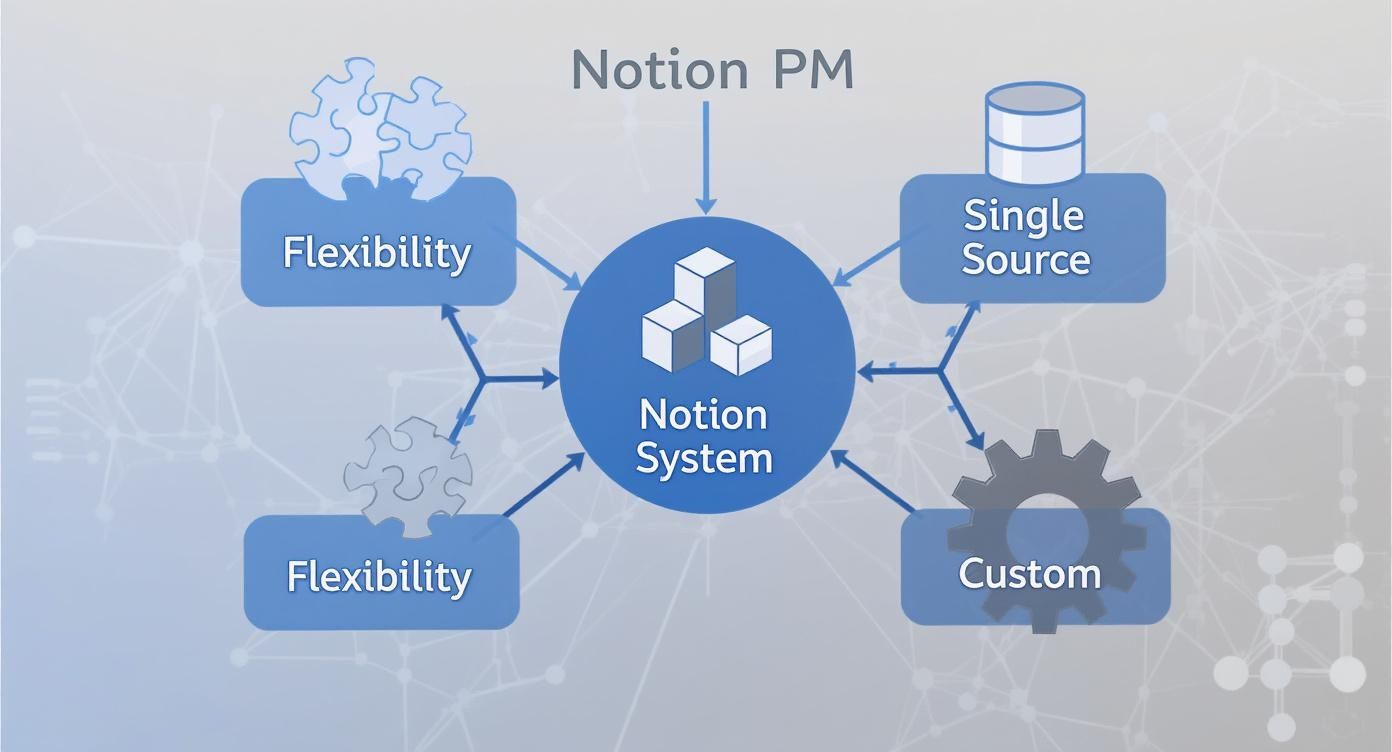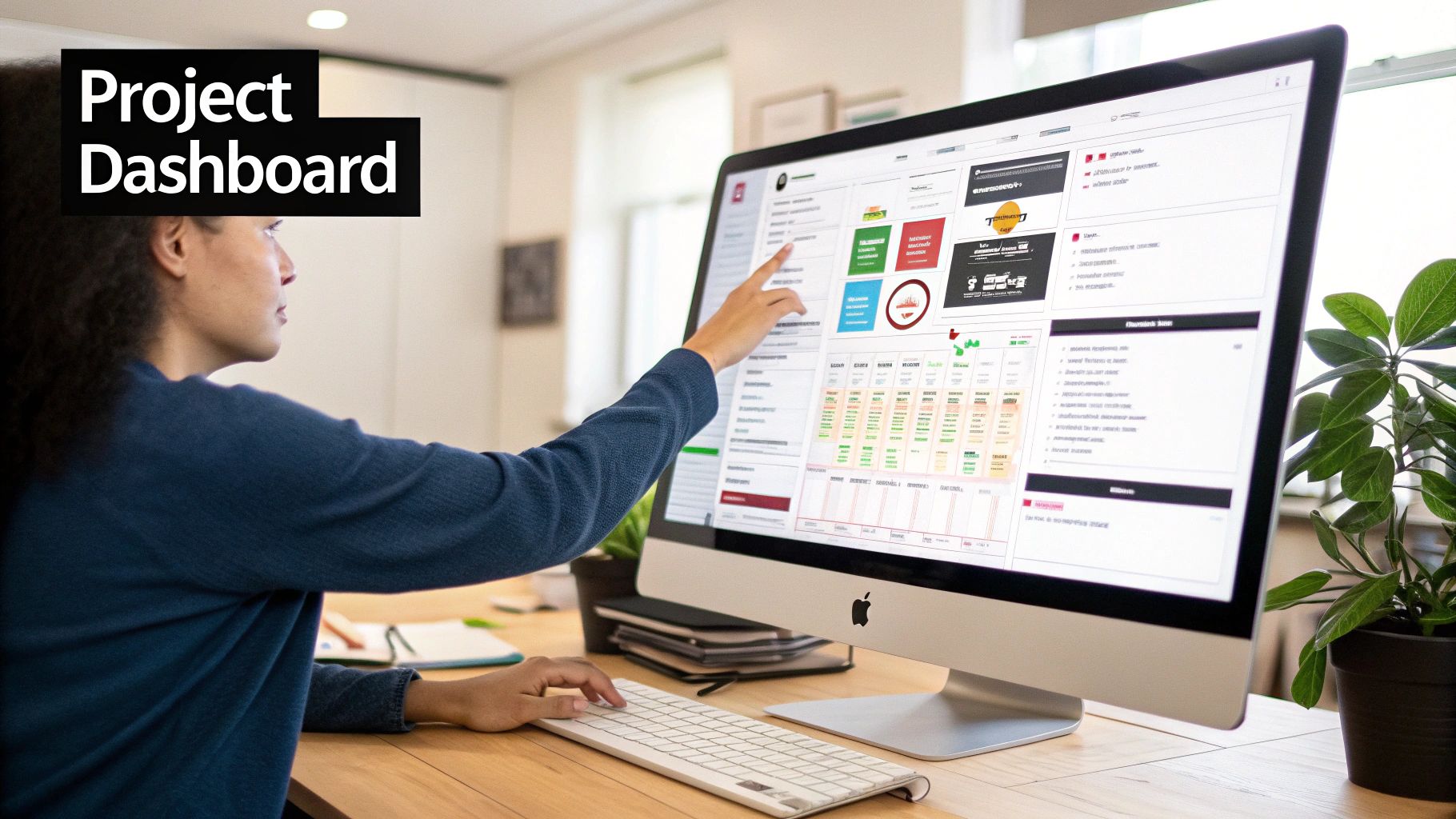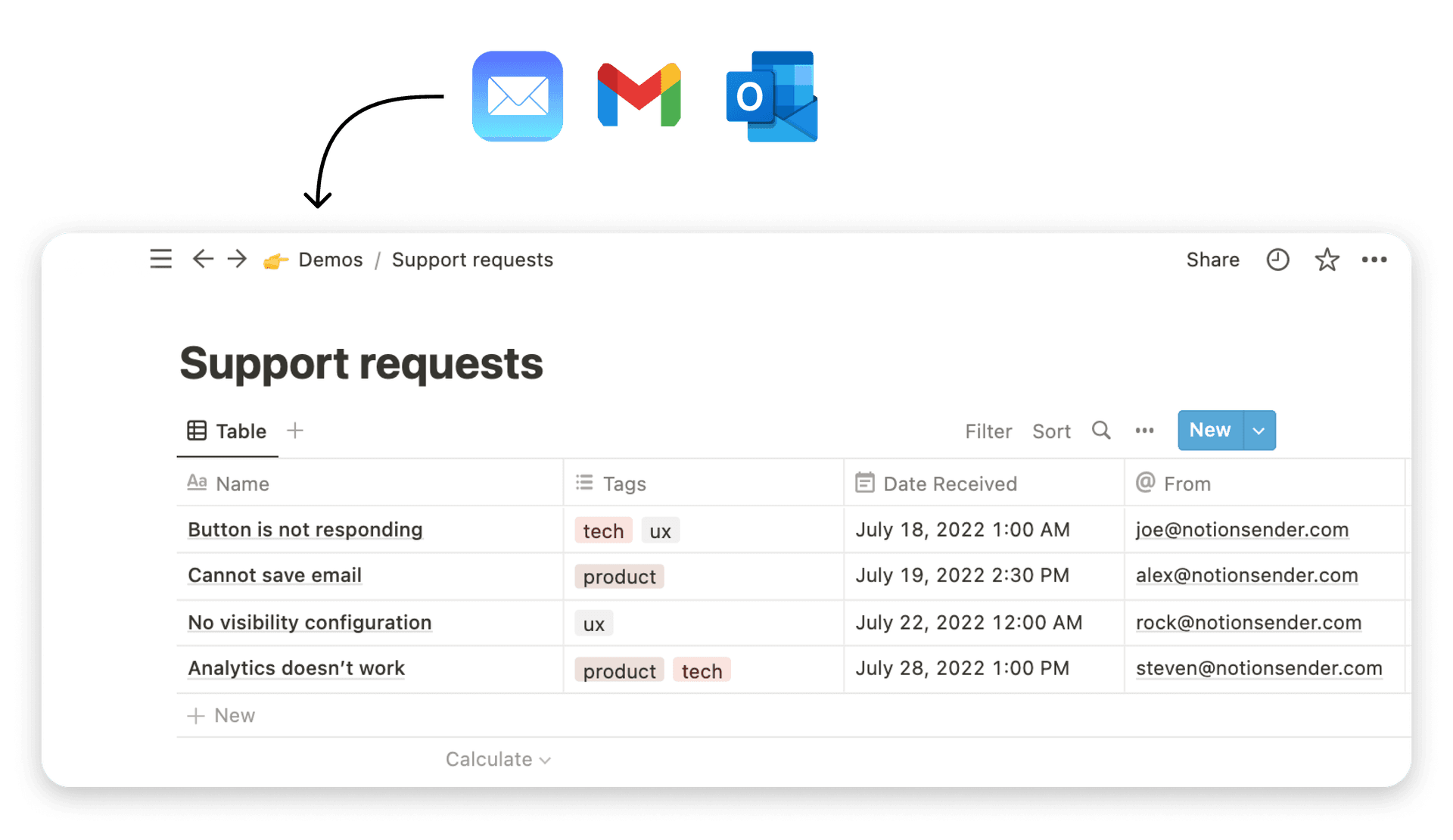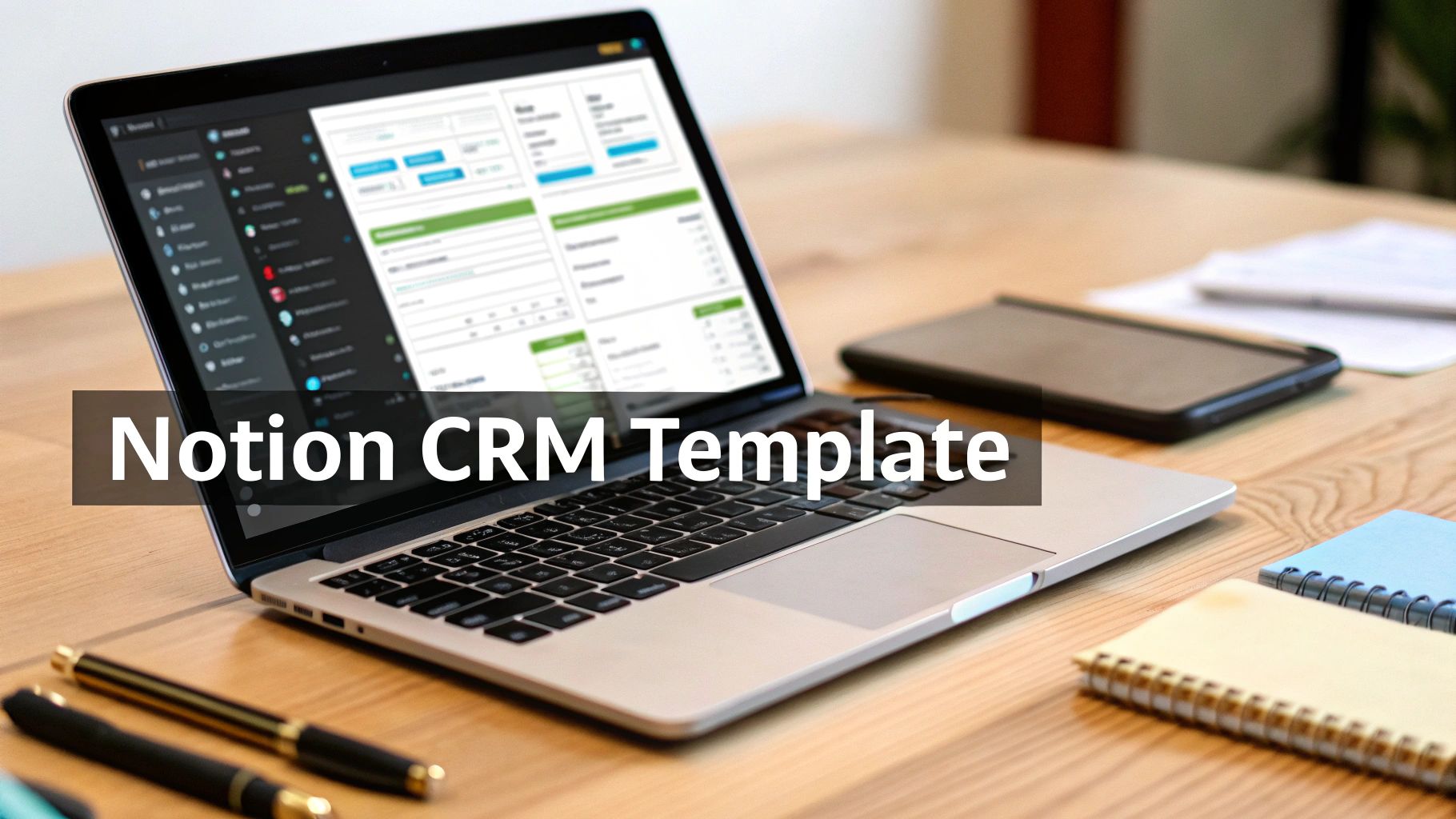Build a Notion Project Management System

Managing projects in Notion isn't about adopting another rigid tool; it's about building a system that actually fits how your team works. Think of it as combining tasks, documents, and databases into a single, flexible space that becomes your team's single source of truth.
This system isn't static. It grows and changes right alongside your projects.
Why Your Team Needs a Custom PM System
Let's be honest, most traditional project management software can feel like a straitjacket. They often lock you into a specific methodology, forcing your unique workflows into predefined boxes that just don't fit.
Ever seen a marketing team trying to run a content calendar on the same platform a dev team uses for agile sprints? It usually ends with everyone juggling multiple tools, leading to siloed information and a lot of wasted time. This is where a custom Notion project management system completely changes the game.
Instead of bending your process to fit the software, you build the software around your process. That kind of flexibility is essential today. The demand for adaptable tools is through the roof—the productivity software market hit a value of $54.8 billion in 2022 and is still climbing. You can dig into the numbers in this productivity software market analysis.
Before we dive into building, it's helpful to see where Notion stands apart from the old guard.
Notion vs. Traditional PM Tools: A Quick Comparison
This table breaks down the core differences between Notion's adaptable approach and the more structured nature of conventional project management tools. It highlights why so many teams are making the switch.
| Feature | Notion Project Management | Traditional PM Tools |
|---|---|---|
| Flexibility | Highly customizable; build from scratch or adapt templates. | Rigid structure; predefined workflows (e.g., Scrum, Waterfall). |
| All-in-One Workspace | Combines docs, databases, and tasks in one place. | Often focused solely on task and project tracking. |
| Learning Curve | Steeper initially due to its "building block" nature. | Generally easier to start with due to fixed features. |
| Cost | More affordable, especially for small to medium teams. | Can be expensive with per-user pricing models. |
| Integration | Strong API, but relies on connections for some functions. | Often have deep, built-in integrations with specific tools. |
Ultimately, the choice comes down to whether your team needs a ready-made solution or a flexible foundation you can build upon. For teams that value adaptability, Notion is a clear winner.
Unlocking True Workflow Flexibility
The real magic is in Notion's interconnected databases. You can create a master 'Projects' database and a separate 'Tasks' database, then simply link them. This one connection means every task is tied to a project, and every project can instantly show all its related tasks.
It sounds simple, but the result is a clean, organized workspace where everything is connected on a single page.
This visual clarity is powerful. Everyone on the team knows exactly what they're responsible for and, more importantly, how their work fits into the bigger picture. It completely demolishes the information silos that pop up when you're using separate tools for documents, tasks, and planning.
A Central Hub for All Your Work
When your team is juggling a dozen different initiatives, having solid strategies for managing multiple projects simultaneously is non-negotiable. A custom Notion system gives you that central hub, a single dashboard with a bird's-eye view of everything in motion.
Imagine logging in and immediately seeing:
- High-level project timelines for a quick executive summary.
- Kanban boards showing the status of each team's sprint.
- Personalized "My Tasks" views so every team member knows their priorities for the day.
When you build a system that reflects your team’s actual communication patterns and operational needs, you're doing more than just organizing tasks. You're creating an environment where efficiency and clarity are built-in, not just bolted on. This tailored approach leads to better adoption and, ultimately, more successful projects.
Constructing Your Foundational Databases
At the heart of any solid project management system in Notion are two interconnected databases. Don't think of these as static spreadsheets; they're living, breathing hubs for all your team's work. We're going to start from scratch and build the two most essential ones: a high-level Projects database and a more detailed Tasks database.
As you get started, it helps to keep a few core principles in mind. Thinking about database design best practices from the get-go will make sure your system is solid and can grow with your team.
This infographic really captures the core strengths of building your system in Notion—it’s all about flexibility, having a single source of truth, and tailoring everything to how you work.

These aren't just isolated features; they all work together to create a seriously powerful and unified workspace.
Creating the Projects Database
First up, let's make a new full-page database and call it "Projects." This is your 30,000-foot view, the place where you track every major initiative your team is working on. The goal here is to add properties that give you quick, high-level context without getting lost in the weeds.
I'd recommend starting with these essential properties:
- Status: This should be a 'Select' property. I typically use options like "Planning," "In Progress," "On Hold," and "Complete." It makes filtering and sorting a breeze.
- Timeline: A 'Date' property is perfect for this. You can set a start and end date, which is absolutely critical for building out those timeline and calendar views later on.
- Project Lead: Use a 'Person' property to assign a single owner. This clears up any confusion about who is ultimately accountable for a project's success.
- Priority: Another 'Select' property works best. Keep it simple with "High," "Medium," and "Low" to help your team know exactly what to focus on.
With just these four properties, you suddenly have a clean, at-a-glance dashboard for your entire project portfolio.
Building the Tasks Database
Next, create another full-page database and name it "Tasks." This is where the day-to-day action happens. Every single to-do item, from "Draft client email" to "Design mockup V2," will get its own entry right here.
The properties for this database are much more action-oriented:
- Due Date: A 'Date' property is a must-have for setting clear deadlines.
- Assignee: Use a 'Person' property so everyone knows exactly who is responsible for what.
- Status: This is another 'Select' property, but I like to use more granular options here, like "Not Started," "In Progress," and "Done."
Now for the most important part: the Relation. Add a 'Relation' property and connect it back to your "Projects" database. This one simple step is the glue that holds the entire system together. Now, every single task can be tied directly back to its parent project, creating a powerful link between daily work and your big-picture goals.
The magic of Notion really shines through with this relational link. It transforms two flat lists into a three-dimensional project map, where you can see not just what needs to be done, but why it needs to be done.
This setup lets you zoom in on a project and see all its associated tasks. Or, you can look at a specific task and immediately know which larger project it contributes to.
This is also where integrations become a game-changer. Think about it: client feedback rolls in via email, and you need to turn it into a task. Instead of the old copy-and-paste routine, you can automate the whole thing by saving emails directly to your Notion database. It's a simple way to make sure no crucial communication ever gets lost in the shuffle.
Alright, you’ve got your foundational databases set up. That’s the hard part done. But right now, they're just collections of data—the raw ingredients. The real magic happens when you turn those raw materials into a central command center, a single dashboard where your whole team can see what's what without getting lost in the weeds.
This dashboard is going to be your team's home base. It’s the place where the big-picture strategy connects with the day-to-day grind, giving everyone clarity on what they need to do. We'll pull this off using one of Notion's best features: linked database views.

Think of a linked view as a live mirror of your original database. You can sprinkle these mirrors all over your workspace and then tweak each one with its own filters, sorting rules, and layouts—all without ever messing up the master database. This is how you create multiple, specialized views from a single source of truth.
Building Your Core Dashboard Views
First things first, create a new, blank page and give it a name like "Project Dashboard." This is our canvas. We're going to start by pulling in a few different angles of your 'Tasks' database.
Let's kick things off with a Kanban board to get a visual on the workflow. Just type the /linked view of database command, pick your 'Tasks' database, and select the 'Board' layout. The trick here is to group the board by the 'Status' property you made earlier. Boom. You can now literally see tasks moving from "Not Started" all the way to "Done."
Next up, a calendar view is non-negotiable for keeping deadlines in check. Add another linked view of the same 'Tasks' database, but this time, go with the 'Calendar' layout. Make sure it's pulling the 'Due Date' property to display the tasks. This gives the entire team an instant, at-a-glance feel for what's coming up and helps you spot potential bottlenecks before they become a problem.
A well-designed dashboard isn't just about showing data; it’s about answering crucial questions fast. "What's my top priority today?" "Which project is falling behind?" "What’s on the calendar for next week?" Your dashboard should surface these answers instantly.
Creating Personalized and Filtered Views
Here's where the dashboard goes from useful to indispensable. We're going to create personalized views that cut through the noise for each person. The goal is simple: show people only what’s relevant to them. That’s a cornerstone of any project management system that actually works.
A "My Tasks" view is an absolute game-changer for individual focus. Here’s how to set it up:
- Drop in another linked view of your 'Tasks' database. A simple 'List' layout works great for this.
- Find and click the 'Filter' button, usually at the top right of the view.
- Set up this one simple rule: 'Assignee' contains 'Me'.
This single filter is incredibly powerful. It dynamically shows anyone looking at the page only the tasks assigned to them. It cuts out all the clutter and tells them exactly what's on their plate. You can rinse and repeat this process for all sorts of things, like views for projects led by a specific manager or tasks flagged with a "High" priority.
This kind of customization is a huge part of why Notion's popularity has exploded, with its user base rocketing from 1 million in 2019 to over 100 million by 2024. You can read more about Notion's rapid expansion and adoption to see just how big an impact these features have had.
By mixing and matching layouts like boards and calendars with smart filters, your dashboard stops being a static page and becomes an interactive hub that adapts to what every single person on your team needs to see.
Alright, let's move beyond just storing information and get Notion to start doing the heavy lifting for you. Once you have your foundational databases and dashboard set up, the real magic begins with automation.
This is how you turn your static project tracker into a dynamic system that actively manages itself. We're talking about reducing the repetitive grunt work, making sure everyone follows the same process, and having critical insights bubble up to the surface automatically.

We'll dig into three of my favorite features for this: database templates, formulas, and rollups. By weaving these together, you'll create a setup that doesn't just hold data but helps you make sense of it.
Standardize Kickoffs with Database Templates
If you want your system to scale, you need consistency. Nothing throws a dashboard into chaos faster than every project manager setting up their projects in a slightly different way. Database templates are your best friend here.
Think of them as a pre-built starting point for any new project. You can create a "New Project Kickoff" template right inside your 'Projects' database. Now, every time someone on your team starts a new project, they can click that template, and it instantly populates the page with everything they need.
For instance, your template could automatically:
- Load a checklist of essential setup tasks, like "Schedule kickoff meeting" or "Define key milestones."
- Include a pre-written project brief with placeholders for goals, scope, and key stakeholders.
- Embed a linked view of your 'Tasks' database, already filtered to show only tasks related to that specific project.
This simple feature ensures every single project gets off the ground with the same solid foundation. It's a huge time-saver and a game-changer for team alignment.
Flag Risks with Simple Formulas
You don't need to be a spreadsheet wizard to use formulas in Notion. With just a few simple commands, you can create properties that react to your data in real-time. A classic, must-have example is an overdue task flag.
Instead of manually scanning due dates every morning, just add a 'Formula' property to your 'Tasks' database. A basic if statement can do the work for you, checking if a task's due date has passed while its status is still incomplete.
if(prop("Due Date") < now() and prop("Status") != "Done", "🔴 Overdue", "✅ On Track")
Pop that formula in, and Notion will stick a red circle emoji next to any task that's late. It's an unmissable visual cue on your Kanban boards and task lists, making it impossible to let deadlines slip by unnoticed.
Measure Progress with Rollups
Finally, Rollups are what tie everything together. A Rollup is a special kind of property that reaches into a related database and pulls back specific information. Since your 'Projects' and 'Tasks' are already linked, you can use a Rollup to get a high-level summary of what's happening on the ground.
One of the most powerful uses for this is a live project completion bar. Right in your 'Projects' database, you can add a Rollup that looks at all the tasks linked to a project, counts how many are marked "Done," and spits out a percentage. Just like that, you have an automated progress bar for every single project, visible right from your main dashboard.
While these features are incredibly useful on their own, their potential explodes when you connect them to other tools through APIs. For anyone with a bit of a technical side looking to build custom integrations, diving into the Notion API documentation is the next logical step to unlocking even deeper automation.
Integrating Email for Seamless Communication
https://www.youtube.com/embed/IS0NPa0yqi4
Let's be honest, your beautifully organized project management system is only as good as the information you can keep inside it. When critical conversations, client feedback, and important approvals are stuck in a dozen different email inboxes, that "single source of truth" you were aiming for starts to feel pretty fragmented.
This is where bridging the gap between your email and your Notion project management setup isn't just a "nice-to-have"—it's a game-changer.
Of course, you could manually copy and paste every important conversation. But that’s a tedious, time-consuming process that’s just begging for human error. The real solution is to connect your email directly to your Notion databases, making sure every piece of communication gets logged exactly where it belongs: right alongside the project or task it relates to.
Connecting Your Inbox to Notion
This is precisely the problem tools like NotionSender were built to solve. Instead of treating your inbox as a separate, siloed channel, they let you pipe emails directly into your Notion workspace as structured data.
The setup is surprisingly simple. You connect your email account and then assign a unique, dedicated email address to a specific Notion database.
For instance, you could have an address like tasks.your-workspace@notionsender.com. Send any email to that address, and the content instantly creates a new entry in your "Tasks" database. It’s a small tweak to your workflow that completely removes the friction of constantly switching between apps.
Here’s a glimpse of what an integration tool's interface often looks like—clean, simple, and designed to get you connected without needing a technical degree.
The main takeaway here is just how straightforward this is. You can link specific databases to email workflows in minutes.
By integrating your email, you're not just saving a few minutes here and there. You're building a richer, more complete project history. Every stakeholder conversation and client update becomes a permanent, searchable part of the project record, open and accessible to the whole team.
Practical Scenarios for Email Integration
Once you're all hooked up, you can finally stop the constant context-switching and start managing communication right from where the work actually happens. The possibilities solve some of the most common workflow headaches out there.
Think about these real-world situations:
- Client Status Updates: A project manager needs to send out the weekly progress report. Instead of starting from a blank email, they just open the project page in Notion, fire up a pre-built email template, and hit send. The best part? A copy of that sent email is automatically logged in a "Communications" database related to that very project page.
- Task Follow-ups: A designer has a question about a specific task. They can send a quick email to the assignee directly from the task's page in Notion. The entire back-and-forth conversation stays attached to the work item itself, providing context for anyone who needs it later.
- Capturing Action Items: The project lead gets a meeting summary email packed with action items. Instead of manually creating new tasks, they simply forward that email to their Notion database's dedicated address. Instantly, those items populate as new tasks, ready to be assigned and tracked.
This kind of deep integration keeps your team focused and ensures all your communication is tied directly to the work it’s about. If you're ready to dive in, you can get a full rundown on how to create and send email from Notion and get started. It’s a huge step toward building a truly unified workflow.
Of course, once you start building out your project management hub in Notion, some questions are bound to come up. It's a big shift, especially for teams used to more rigid tools. Let's walk through a few of the most common hurdles people hit when they make the switch.
Can Notion Really Replace a Tool Like Jira or Asana?
For a lot of teams, the answer is a straight-up "yes." The magic of Notion is its insane flexibility. A tool like Jira is obviously purpose-built for agile software development, and Asana gives you a more traditional, structured project view. Notion, on the other hand, is a blank canvas. It lets you build a system that actually mirrors how your team already works.
It shines brightest for teams who need to mix their project tracking with wikis, documentation, and meeting notes—all in one spot. But, let's be real. If your entire workflow hinges on super-specific features like advanced sprint reporting or gnarly dependency chains, a dedicated tool might still be your best bet. It all comes down to weighing Notion's open-ended customization against the need for those specialized, out-of-the-box features.
At the end of the day, the best project management tool is the one your team actually uses. Notion's adaptability often wins people over because you can shape it to fit your process, not the other way around.
Is Notion Secure Enough for Sensitive Projects?
Security is always a huge concern, and it's clear Notion has been investing heavily here. You've got features like SAML SSO, audit logs, and the platform is SOC 2 Type 2 compliant. All your data is encrypted both at rest and in transit.
For most businesses, these safeguards are more than enough to keep company info locked down. That said, if you're in a highly regulated field like finance or healthcare, it's just good practice to review Notion’s security documentation for yourself. You'll want to be absolutely sure it ticks all your specific compliance boxes before you start moving sensitive project data over.
What Are the Biggest Mistakes to Avoid?
Oh, this one's easy. The number one trap people fall into is over-engineering their setup from day one. It's so tempting to build this intricate web of connected databases with fancy formulas and complicated rollups right out of the gate. But that almost always ends with a system that's too confusing for anyone to actually use.
A few other pitfalls to watch out for:
- Starting Too Complex: Just begin with the basics—a database for projects and one for tasks. That’s it. You can always layer on more complexity later as you find a real need for it and the team gets comfortable.
- Forgetting Templates: If you don't create standardized database templates, you're asking for trouble. Inconsistent data entry will turn your slick dashboards into a messy, unreliable report in no time.
- Skipping Team Onboarding: Don't just build it and expect them to come. You have to walk your team through the setup, explain the "why" behind your decisions, and get their feedback early and often.
A simple system that everyone understands will always beat a complex one that nobody touches.
Ready to stop communication silos from derailing your projects? NotionSender integrates your email directly into your Notion workspace, ensuring every conversation is logged and actionable. Try NotionSender today and build a truly unified workflow.

